Fort Sumter
More information at
Fort Sumter (1842-1947) - A Third System masonry fort begun in 1829 and unfinished when the U.S. Civil War began in 1861. Located in Charleston Harbor, Charleston County, South Carolina. Attacked by Confederate forces on 12 Apr 1861, marking the beginning of the U.S. Civil War. Named after General Thomas Sumter, Revolutionary War Hero. Fort Sumter became a National Historic Monument in 1948.
 |
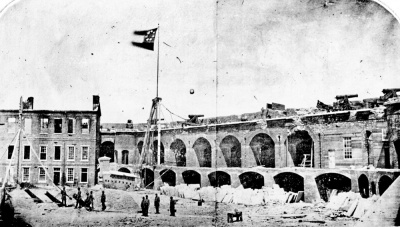 |
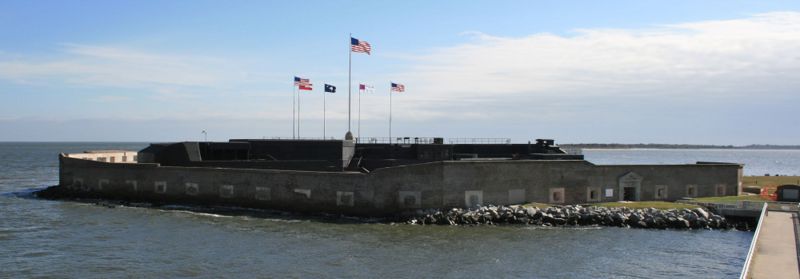 | |
Third System (1816-1867)
Part of the Harbor Defense of Charleston. Established as one of the forts protecting the entrance to Charleston Harbor along with Fort Moultrie and Castle Pinckney.
The land for Fort Sumter was procured on 21 Dec 1836 by the resolution of the General Assembly of the State of South Carolina. Construction on the Third System masonry fort begun in 1829.
Fort Sumter was built upon a sandbar in Charleston Harbor. Seventy thousand tons of New England granite were imported to build the base of the structure. The fort itself was a five-sided brick structure, 50' high and 170' by 190', with walls 5' thick. It was designed to house 650 men and 135 guns in three tiers of gun emplacements, it was never filled to capacity with guns or men.
U.S. Civil War (1861-1865)

The Confederate attack on Fort Sumter on 12 Apr 1861 marked the first battle and the real beginning of the U.S. Civil War. The shelling of the fort continued for 34 hours. The fort commander, Maj. Robert Anderson, surrendered on 13 Apr 1861 and the fort remained in Confederate hands until 22 Feb 1865.
During the war, the fort suffered considerable damage from Union bombardments and it is estimated that 3,500 tons of shells were rained down on the fort just between Apr 1863 and Feb 1865. At the end of the war, only one wall remained standing with the others just jagged piles of rubble.
After the U.S. Civil War Fort Sumter was reconstructed but reduced to a two-tier structure. The first tier was restored with 100-pounder Parrott rifles. The fort was unmanned in the years between 1876 and 1897.
-
Interior View of Fort Sumter, April 1861
-
East Face taken after 1861
-
East Face
-
Fort Sumter Interior, 1863-65
-
Fort Sumter with the newly relocated lighthouse, 1872
Endicott Period (1890-1910)
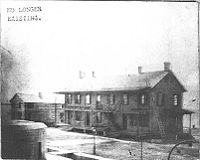
Construction of the 12" Battery Huger began in 1897 and was transferred for service on 15 Jun 1899. This was the only Endicott Period gun battery built on Fort Sumter. The battery was constructed across the center of the parade. Battery Huger was a bit unusual because it had two different carriages for the 12" guns, one was a Barbette carriage and the other was a disappearing carriage.
Post construction was very limited on Fort Sumter during the Endicott Period. The post operated on a detachment basis as a sub-post of Fort Moultrie. The most substantial building on the post was a fifty-man barracks constructed in 1900. That barracks were torn down and replaced by a six-man detachment barracks in 1914. There was also a caretakers cottage/NCO quarters on the post.
| Battery Click on Battery links below |
No. | Caliber | Type Mount | Service Years | Battery Cost | Notes |
|---|---|---|---|---|---|---|
| Battery Huger | 1 1 |
12" 12" |
Disappearing Barbette |
1897-1898-1899-1943 | $ 97,200 | |
| Source: CDSG | ||||||
World War I (1917-1918)
The post was manned during World War I by a small garrison. To support the small garrison, two sets of temporary WWI barracks were constructed on what was left of the parade. The two barracks included officer's quarters, officer and enlisted mess, a kitchen, and latrines. The 1921 plan still shows the temporary buildings. The temporary buildings were removed later in the 1920s.
Also shown on the 1921 plan is a trestle walkway leading out to a single 60" searchlight over the water.
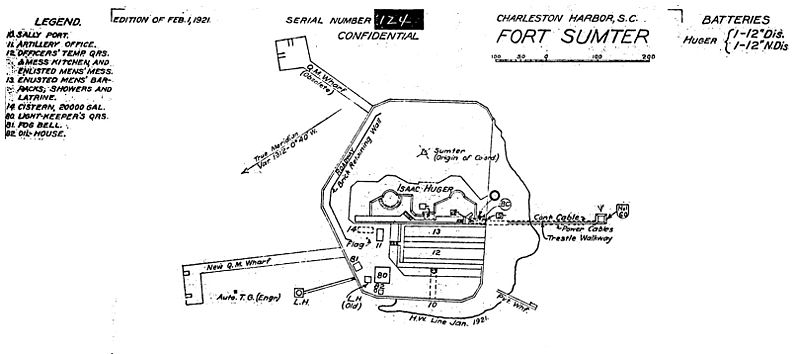
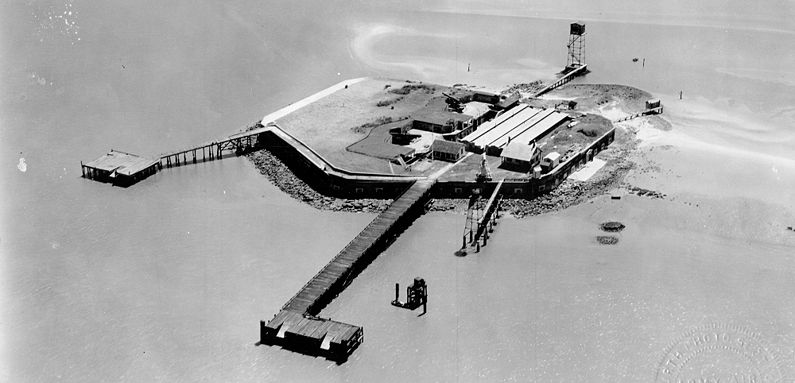
World War II (1941-1945)
During World War II, two 90mm AMTB guns were placed in Battery AMTB - Fort Sumter for motor torpedo boat defense and anti-aircraft defense. Battery AMTB - Fort Sumter was the only active battery on the island after Battery Huger was deactivated in 1943. Only the two fixed guns of the AMTB battery were emplaced, the two mobile guns remained in storage at Fort Moultrie. Two 60" searchlights were installed on steel towers to support the AMTB battery.
Just as in World War I, two temporary barracks were built to support a small garrison at Fort Sumter along with a separate mess hall and latrine.
| Battery Click on Battery links below |
No. | Caliber | Type Mount | Service Years | Battery Cost | Notes |
|---|---|---|---|---|---|---|
| Battery AMTB - Fort Sumter | 2 2 |
90mm 90mm |
Fixed Pedestal M3 Mobile M1A1 |
1943-1943-1943-1946 | $ 13,471 | |
| Source: CDSG | ||||||
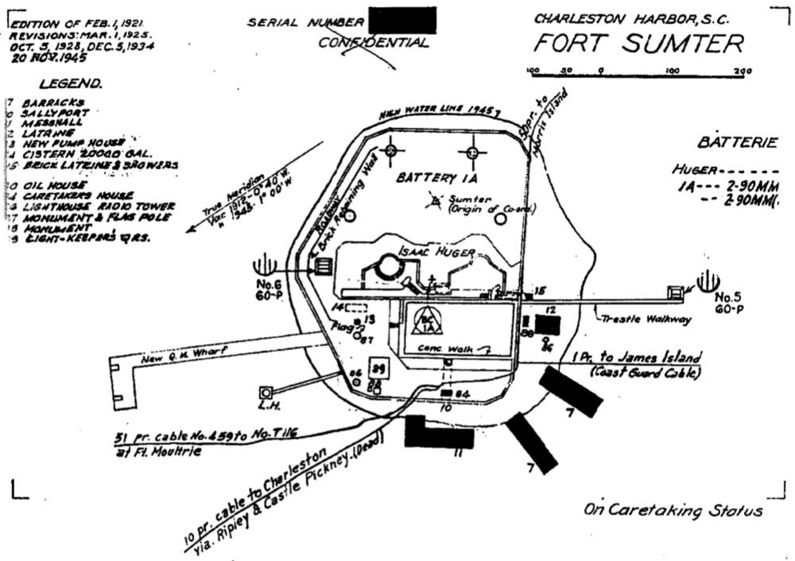
| Assumed | Relieved | Rank | Name | Cullum | Notes |
|---|---|---|---|---|---|
| 1860-12-26 | 1861-04-01 | Major | Anderson, Robert | 406 | Forced to surrender to Confederates at the start of the U.S. Civil War Transferred his command from Fort Moultrie |
| 1863-09-04 | 1864-05 | Lt. Col. | Elliott, Stephen | N/A | Confederate commander. |
| 1864-05 | 1864-07-20 | Capt. | Mitchel, John C. | N/A | Confederate commander. Killed in the third bombardment of the fort. |
| 1864-07-20 | 1865-02-17 | Capt. | Huguenin, Thomas A. | N/A | Last Confederate commander. He evacuated the fort but did not surrender it. |
| Dates are formatted in yyyy-mm-dd to sort correctly. The Cullum Number is the graduation order from the United States Military Academy by year and class rank and links to a page for the officer on the website version of the Cullum Register. Listings without a Cullum Number indicate that the person was not a graduate of the United States Military Academy. | |||||
Current Status
Fort Sumter became Fort Sumter National Historic Monument in 1948. The Fort can be reached by a 30-minute boat ride from Charleston, South Carolina. Many mounted and unmounted pre Endicott Period guns and many interpretive displays. Must see.
|
{"selectable":false,"height":"-500","width":"-500"} |
Location: Charleston Harbor, Charleston County, South Carolina. Maps & Images Lat: 32.75234 Long: -79.87465 |
|
See Also:
Sources:
- Lewis, Emanuel Raymond, Seacoast Fortifications of the United States: An Introductory History, Naval Institute Press, Annapolis MD, 7th printing, 1993, ISBN 1-55750-502-0, page 51
- Kaufmann, J.E. and Kaufmann, H.W., Fortress America: The Forts That Defended America, 1600 to the Present, DaCapo Press, 2004, ISBN 0-306-81294-0, page 236-239
- Roberts, Robert B., Encyclopedia of Historic Forts: The Military, Pioneer, and Trading Posts of the United States, Macmillan, New York, 1988, 10th printing, ISBN 0-02-926880-X, page 722-723
Links:
- North American Forts - Fort Sumter
- National Park Service
- Wikipedia - Fort Sumter
- Battle of Fort Sumter
Visited: 22 Feb 2018, 23 Jan 2010
Picture Gallery
-
Fort Sumter Entrance Sign
-
Fort Sumter Casemates
-
Fort Sumter Parrot Gun
-
Fort Sumter Gun in Casemate
-
Fort Sumter Mine Casemate
-
Fort Sumter Mine Casemate Entrance
-
Fort Sumter Quarters Ruins
|}
- Visited
- All
- South Carolina All
- South Carolina Forts
- Coastal Forts
- South Carolina Charleston County
- Third System Forts
- Endicott Period Forts
- World War I Forts
- World War I Coastal Forts
- World War II Forts
- World War II Coastal Forts
- Harbor Defense of Charleston
- Civil War Defenses of Charleston
- Fort Sumter
- 2009 Southern Trip
- 2018 Research Trip
- Must See











